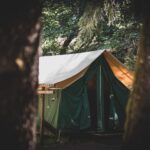
Backpack-tent-buying-guide
On a backpacking trip, the quality of your tent may make a huge impact. However, choosing the best design for you will depend on a number of variables, including your trip frequency, length of time, and destination; this same likely rain and wind; the distance you prepare to carry your tent; whether you want to go alone, with others, or with dogs; which extra features are most important to you; and, of course, your budget.
Double-Wall Tent– 3 primary components make up a double-wall tent: (a) an inner tent with a non-waterproof canopy (most often mesh) and a waterproof floor, (b) poles, and (c) a waterproof rainfly. The majority of double-wall tents are comfy, quick to set up, and completely insect and rain-proof. A double wall freestanding tent is certainly what comes to mind when you keep your eyes closed.
Semi-freestanding – Tents that are semi-freestanding have their own set of poles but also need a few anchors or guy points to be fully erected. Since it provides the safety and comfort of a double-wall tent while decreasing weight by reducing some of the pole architecture, this design is becoming more and more popular.
Tarp-tents – Tarp tents need trekking poles and stakes for support because they can’t stand up on their own. They are often single-wall construction, which can lead to more condensation build. Tarp tents are often not the greatest option for beginner trekkers if you’re going ultralight.
THINGS TO CONSIDER
Weight: Hikers who are concerned about their weight may prioritise a tent’s weight over its usable size and are likely to be attempting long backcountry distances. For hikers searching for a compact, one-person shelter is a wonderful choice.
Space: The more space you have in your tent, the easier it will be for you to sit up, walk around, change, and pack up in the morning. The one obvious drawback of selecting a larger shelter is that hauling greater weight also means carrying a larger tent. Backpacking tents provide a little bit of extra floor area and are designed to fit people with a 20-inch width.
Setup: Most hikers will prefer a tent that erects swiftly and easily since they want to dine as soon as possible after a strenuous day of hiking. Many tents include single-hub pole arrangements that may be folded for transport and then quickly snapped together to support the tent body.





